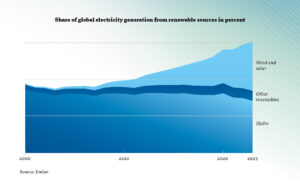In 2024, the demand for electrical energy has experienced its largest growth in the past twenty years, and experts predict a similar demand for 2025. The good news: more and more sustainable energies are meeting the world’s energy hunger. Photovoltaics alone account for around half of this increase.
The growth in global electricity demand this year and next year will be among the fastest in the past two decades,” says Keisuke Sadamori, Director for Energy Markets and Security at the International Energy Agency (IEA).
The reasons are robust economic growth, severe heatwaves, and the increasing prevalence of technologies powered by electricity, such as electric cars and heat pumps.
Expansion of Renewable Energies
Parallel to this, a rapid expansion of renewable energies can be observed. Compared to 2022, according to market analysts from McKinsey, about 50 percent more capacities from renewable energy sources (a total of 507 gigawatts) were installed worldwide in 2023. Their share of the global electricity supply will therefore continue to increase from an expected 30 percent in 2023 to 35 percent in 2025. Photovoltaics alone will account for about half of the increase in global electricity demand in 2024 and 2025, and together with wind energy, photovoltaics could even make up three-quarters of the increase in demand.
Even more impressive are the figures from the European Union: according to Eurelectric, the industry association of the European electricity industry, 74 percent of the electricity generated in the EU in the first half of 2024 came from renewable and low-carbon energy sources. However, these figures also include electricity from nuclear power plants.
“It is encouraging to see the share of clean energy in the electricity mix continuing to rise, but this needs to happen much faster to meet international energy and climate goals,” warns IEA Director Sadamori.
Increasing Efficiency of Technologies
In parallel with the accelerated expansion, the efficiency of technologies used to generate energy from renewable sources is also increasing. The average efficiency of photovoltaic modules today is about 22 percent; by 2030, an increase to at least 25 percent is expected, according to the “Photovoltaics” status report published by the Association of German Engineers (VDI). There have been even greater successes with the prices of photovoltaic modules, which have fallen by 90 percent in the last ten years.
Hopeful Prospects with Perovskites
Silicon-based photovoltaic cells have now been developed to such an extent that they are reaching their efficiency limits, with their theoretical maximum efficiency at 33 percent. Much hope is therefore placed on the material class of metal-halide perovskites. Solar cells based on this material quickly achieved efficiencies comparable to commercial silicon solar cells after their discovery. Additionally, perovskite solar cells have other decisive advantages: the manufacturing and energy costs are low compared to established silicon technology because they can be produced using cost-effective coating processes. This also allows the production of multi-layered solar cells. Tandem cells, where one layer captures photons with high energy and the other captures those with low energy, theoretically achieve efficiencies of up to 45 percent. A research team at the Fraunhofer Institute for Solar Energy Systems ISE has shown that triple solar cells consisting of perovskite-perovskite-silicon sub-cells are also very promising. Classic silicon solar cells have an open-circuit voltage between 0.7 and 0.8 volts.
“If we can measure a voltage of over 2.8 volts with the perovskite-perovskite-silicon solar cell, we can truly infer enormous electricity generation potential,” says Dr. Juliane Borchert, Group Leader for Perovskite-Silicon Technologies at Fraunhofer ISE and the University of Freiburg. “This is a record for this type of solar cell and shows that photovoltaics can still expect a lot from the combination of perovskite and silicon.”
New Ideas for Wind Power
Wind turbines are also evolving. Most noticeable is their increasing size: current turbines are up to 160 metres tall and achieve outputs of 5 megawatts (onshore) and 15 megawatts (offshore), a multiple of the initial capacity. Efforts are also being made to improve these turbines, with completely new designs being experimented with: the Dutch company TouchWind, for example, has designed an offshore wind turbine equipped with a single 200-metre-long blade. The system is expected to cost only about a third of the known three-bladed standard variants – while providing the same performance. Vortex Bladeless systems even operate without rotors: the cylindrical construction uses wind vibrations to generate energy. Research is also being conducted on future technologies such as superconducting generators. These only come into play for sizes well over 10 megawatts but then open up a whole new field for drastically improved designs, which in turn lead to further cost reductions or a broader range of applications.





